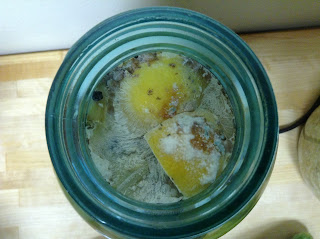 |
| The Gingeriest Ginger Brew |
My first try pictured to the left did
not get it's bubbly activity like normal. After a week of feeding the "bug" that wasn't bugging, I gave up. However, instead of wasting all that good sweet gingery juice, I strained it out and combined it with rooibos, fresh lemon juice, and kombucha and bottled it. This seemed to make a great brew - no complaints! However, I do want to make this ginger bug thing work, so I read a bit more online and found some good tips and a new recipe from Wellness Mama. Apparently, a ginger bug should not be stored next to other cultures or it can experience cross-contamination and fail. There is also a debate about whether the ginger skin should be removed or used. Some people believe that peeling the skin removes too much of the natural lactobacilli which is needed for the culture.
 |
| Ginger Bug First Try - Flop! |
The new recipe I found calls for more water and less ginger and sugar added on a daily basis, which is also more economical, so I'm happy to give it a try. My new ginger bug got a new (larger) jar, a new cover (coffee filters), and a new spot to sit in (on top of the fridge). It is now on day three and it is bugging! I can start to see some bubbling and foaming on top of the water, which makes me excited. This one needs at least eight days of culturing before it will be ready to brew, so keep tuned and I'll let you know how it goes! After I conquer ginger brew, I plan to expand my horizons to home-brewed root beer.
By the way - the grolsch bottles are a new investment for me and they are awesome! Definitely worth it. I got them here. I split a case with a friend to get them cheaper.


















